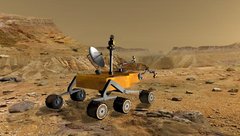Mars Science Laboratory
|
|
Mars_Science_Laboratory_drawing.jpg
The Mars Science Laboratory (or MSL for short) is a NASA rover scheduled to launch in December, 2009 and perform a precision landing on Mars in October, 2010. This rover will be 3 times as heavy and twice the width of Mars Exploration Rovers that landed in 2004. It will carry more advanced scientific instruments than any other previous mission to Mars. The international community will provide most of these instruments. The MSL rover will be launched by an Atlas V or Delta IV medium class booster. There is some discussion of NASA of delaying the launch to 2011 and sending two or three identical rovers [1] (http://www.space.com/news/mars_overhaul_050311.html)[2] (http://mainlymartian.blogs.com/semijournal/2005/03/msl_shakeup_and.html#comments).
The MSL is expected to weigh 600 kg including 65 kg of scientific instruments, compared to the MERs which weigh 185 kg including 5 kg of scientific instruments.
At least 7 instruments have been selected for development or production for MSL:
- A mast camera set, a Mars hand lens imager and a Mars descent imager, all led by Malin Space Science Systems.
- A chemistry and micro-imaging sensor, led by Los Alamos.
- An alpha-particle-X-ray-spectrometer, led by the Max-Planck-Institute for Chemistry.
- An X-ray diffraction and fluorescence instrument, led by the NASA Ames Research Center.
- A sample analysis instrument, led by the NASA Goddard Space Flight Center.
- A pulsed neutron source and detector for measuring hydrogen, provided by the Russian Federal Space Agency.
- A meteorological package and an ultraviolet sensor provided by the Spanish Ministry of Education and Science.
MSL will be set down on the Martian surface using a new NASA high-precision entry, descent, and landing (EDL) system that will place it to within 6 kilometers of an intended target, in contrast to the 150 kilometer error for current landing systems. The EDL system would have an aeroshell with a small trim tab at the base for guidance during the entry phase, which would be followed by deployment of a two-stage parachute system and discard of the aeroshell.
The rover will feature a "smart" landing system that will have a laser or radar altimeter, working in conjunction with a visual-camera based mapping to allow the landing system to autonomously select its precise landing area in order to avoid hazards.
Earlier landing system proposals for the rover featured a "pallet" with a liquid fueled rocket thruster system to land the rover in the final seconds of descent. The pallet would either use airbags or a "crushable" design to permit a safe landing.
Later landing system proposals feature a sky crane system: a platform above the rover with liquid fueled rocket thrusters on arms extending around the rover will stop the descent in midair several meters above the martian surface, the rover will be lowered down by a tether and gently placed on the martian surface, the platform will then fly off to crash land away from the rover.
Once on the ground, MSL will analyze dozens of samples scooped up from the soil and cored from rocks as it explores with greater range than any previous Mars rover. It would investigate the past or present ability of Mars to support life.
The rover will probably be powered by radioisotope thermoelectric generators (RTGs). Solar power is not a good power source for Mars surface operations and was only used on Mars Pathfinder and MER because of politically imposed flight restrictions on RTGs. Solar power systems cannot operate effectively at high Martian latitides or in any shaded areas or in dusty conditions, and it cannot provide power at night and thus limit the ability of the rover to keep its systems warm, reducing the life expectancy of the electronics. RTGs can provide reliable, continuous power day and night, and waste heat can be used via pipes to warm systems, freeing electric power to operate the vehicle and instruments only. The first successful Mars landers, Vikings 1 and 2 in 1976, were RTG powered and the Viking 1 lander worked for 7 years on the Martian surface. The proposed power plant will use Next Generation RTGs: Either Boeings Multi-Mission Radioisotope Thermoelectric Generator which is a more mission flexible and compact power system under development and based on conventional RTGs, or Lockheed Martins Stirling Radioisotope Generator, which is a more efficient but untested for outer space use.
External links
- JPL MSL site (http://centauri.larc.nasa.gov/msl/)
- Mars Science Laboratory Acquisition Program (http://mars.jpl.nasa.gov/missions/future/msl.html)
- Short description of EDL system (PDF) (http://acquisition.jpl.nasa.gov/rfp/motion-simulator/MSL_EDL_Overview.pdf)
- Next on Mars (http://www.spacedaily.com/news/mars-future-05f.html) (Bruce Moomaw, Space Daily, March 9, 2005): An extensive overview of NASA's Mars exploration plans, with many details on the Mars Science Laboratoryde:Mars Science Laboratory

